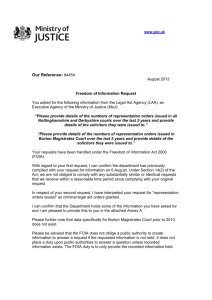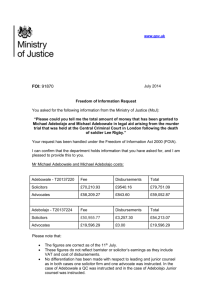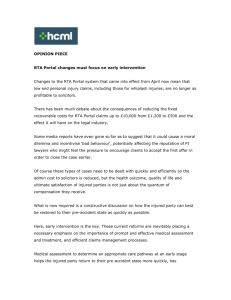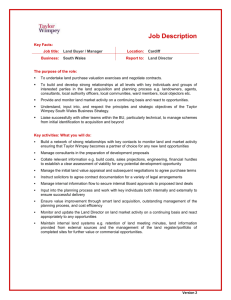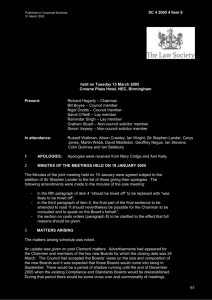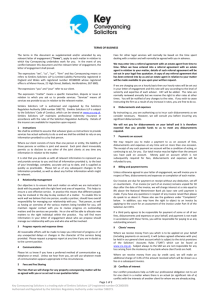Your Clients – Your Business - the Law Society`s governance website
advertisement
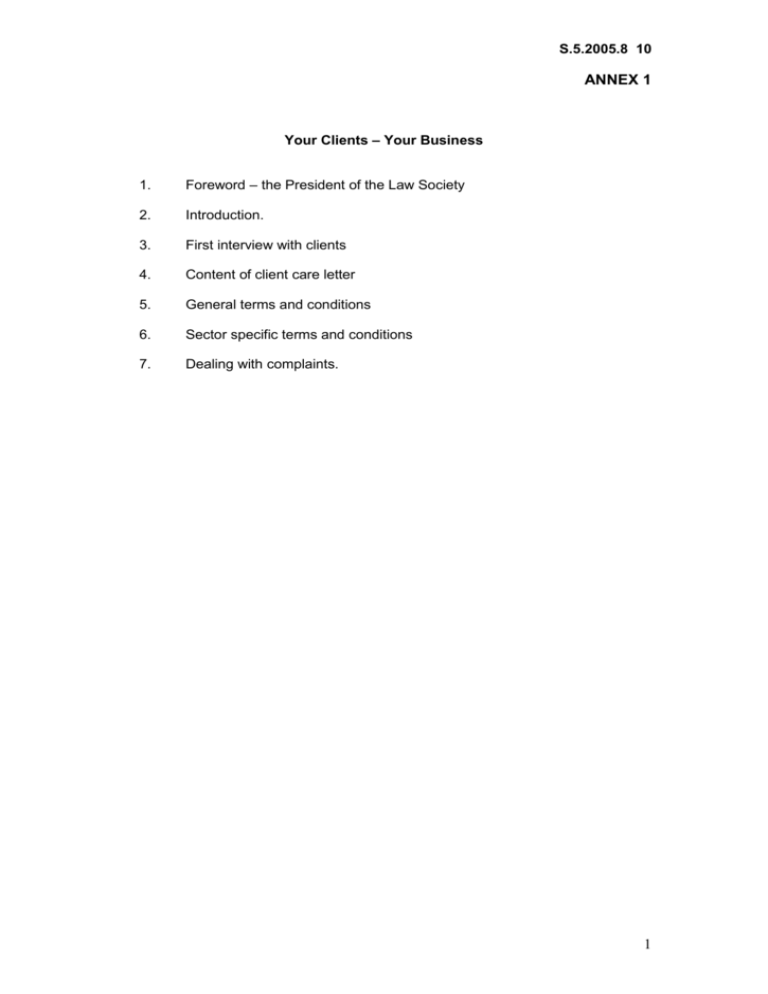
S.5.2005.8 10 ANNEX 1 Your Clients – Your Business 1. Foreword – the President of the Law Society 2. Introduction. 3. First interview with clients 4. Content of client care letter 5. General terms and conditions 6. Sector specific terms and conditions 7. Dealing with complaints. 1 S.5.2005.8 10 ANNEX 1 1. Foreword – From the President 2 S.5.2005.8 10 ANNEX 1 2. Introduction This guide has been developed to help solicitors in their dealing with clients. The information in it has been drawn from a number of different departments within the Law Society who have regular dealings with solicitors. Drawing on their experience, we have been able to identify best practice and also some of the pitfalls that can give rise to problems for solicitors. This guidance deals with: a) First interviews (fixed fee or no fee interviews). b) Client care letters and terms and conditions. c) Dealing with complaints. This guidance raises issues which you need to address in your firm. Because of the diversity of the profession and the fact that most solicitors are now familiar with, and have developed their own terms and conditions, it was not considered appropriate to be prescriptive and produce terms and conditions that would in any event not suit the style or practice of every office. Where particular wording is prescribed by statute, or has been recommended by a Committee of the Law Society, then it is set out in full, together with a reference to its source. We have tried to produce a document which will assist solicitors. There may be issues that we have not addressed or new issues that should feature when this guidance is updated. We would welcome comments from the profession that would enable us to improve on this guide in subsequent versions. Please address your comments to ………………………………… By following this guidance you will be well placed to identify and meet clients’ needs and expectations and deliver benefits both to your clients and your business. 3. First interview with clients Solicitors are sometimes uncertain as to what is expected of them in regulatory terms when they see a prospective client for the first time. The preliminary interview can be on a “no fee” or a “fixed fee” basis, and there may be no further involvement with the interviewee once the interview has concluded. It is appreciated that these guidelines probably cannot be applied in all situations, but it is hoped that by following these guidelines where possible solicitors will avoid some of the difficulties that have come to our attention. Interviews on a “no fee” or “fixed fee” basis are considered to be helpful to clients and solicitors alike in identifying whether there are issues that need to be taken further by solicitors. The problems that have come to our attention and which this guidance is designed to address are: 3 S.5.2005.8 10 ANNEX 1 How do solicitors comply with Practice Rule 15 in terms of these preliminary interviews? If solicitors are charging (even reduced fees) what information should be given to the interviewee? How can solicitors guard against conflicts arising between interviewees and existing clients which might necessitate the solicitor having to cease acting for the existing client? In some instances we have been informed that a conflict has been deliberately engineered to preclude a firm from continuing to act on a matter. This is done by the interviewee revealing information to the solicitor which creates a conflict with the existing client. The firm may then have to cease acting for their existing client. It is therefore important that conflict checks are made. Should solicitors be doing identification checks at or before the interview? Is a solicitor required to write to the interviewee after the interview, even if the solicitor will have no further involvement with that person? The following are suggested guidelines to deal with these issues, and minimise the difficulties that a solicitor may face. They are good practice guidelines and should be applied as a minimum standard. Solicitors should inform their staff as to these requirements, explaining why they are necessary, so that the staff can respond to any queries from enquirers about why the information is needed before the interview takes place. 1. When an appointment is made in advance, even if it is a meeting out of the office, the following information should be obtained from the interviewee:(i) Their name, address and telephone number. (ii) The field of law involved e.g. matrimonial, crime etc. (iii) Name of the opponent or others involved in the matter if applicable. This should enable the solicitor to do a conflict check. If there is a conflict the interviewee can be telephoned and the interview cancelled. If it is a “walk in” surgery then these checks should be done before the interview takes place, and if the check reveals a conflict no interview should take place. 2. When the interviewee attends the office they are given the following information in writing: (i) The name and status of the solicitor or other person conducting the interview. (ii) Confirmation either: (a) That the interview is free. (b) That the cost of the whole interview is £X 4 S.5.2005.8 10 ANNEX 1 (iii) (c) That the cost of the interview is at a reduced cost of £X per hour pro rata. (d) That the first Y minutes are free, and thereafter they will be charged pro rata at the rate of £X per hour. Details of who to contact if the interviewee has a complaint. This information can be prepared in a pro forma document in advance. Interviewees should sign and date the document thereby acknowledging receipt. The firm should keep a copy of the signed document. There is no objection to solicitors, who on the reverse of that document may wish to set out the legal matters that the firm specialises in, and the contact details of the firm or individual solicitors. The client will take this document away with them. 3. It is not necessary for identification checks to be done where legal advice alone is being sought, which at this stage is presumably all that happens. However, if taxation advice is to be given identification should be taken. (See Chapter 3 Law Society Money Laundering guidance, www.lawsociety.org.uk). If the solicitor continues to act for the interviewee, then the usual identification checks will be required where appropriate. 4. Solicitors are reminded that the duty of confidentiality applies to information obtained in this interview, even if the matter goes no further. 5. After the interview has finished, the solicitor’s notes of the interview should be kept with the copy information form that was signed by the interviewee, and filed away and kept for record purposes. 6. There is no need for the solicitor to write to the interviewee unless: (i) the solicitor agrees to do this during the course of the interview; (ii) the solicitor will act further for the interviewee, in which case the solicitor’s usual terms of engagement letter containing all the usual client care information should be sent to the client. (iii) the solicitor wants to record the advice he has given, so that there can be no misunderstanding of what was said. If the solicitor intends to charge for the letter then the solicitor should agree the cost of the letter with the interviewee, and record that agreement in his notes of the interview. 5 S.5.2005.8 10 ANNEX 1 7. If an “agreed fee” is charged then it should be evidenced in writing (this could be by writing on the bill “agreed fee”) and then the money MUST be paid direct into office account. An agreed fee in this context is a fee that is fixed, so in the examples above only 2(ii)(b) is an agreed fee, (see Rule 19(5) and note (xiii) of the Solicitors’ Accounts Rules 1998) Rules and Ethics November 2004 4. Content of client care letter Since the client care rule came into force, solicitors have adopted a number of different approaches and styles in their client care letter. Some solicitors put their terms and conditions in their client care letter. The result is a letter that may extend to many pages. Other solicitors do a relatively brief client care letter, and append a separate terms and conditions document that will run to several pages. In regulatory terms neither approach is wrong, and it is for the individual solicitor to decide what suits him best. However, as we seem to be moving to the position where more terms and conditions may be necessary because of the complexity of practice, we think that more solicitors will proceed on the basis of a separate terms and conditions document. The guidance is therefore based on that premise, although clearly solicitors who do not favour that approach can simply import the required terms and conditions into their letters. We have tried to provide a comprehensive list of general terms and conditions for you to consider. Not all of them may apply to your practice. We would encourage solicitors to be selective in deciding which ones should go in their terms and conditions document. You should also consider whether additional terms and conditions are appropriate given the nature of the work you deal with. A good client care letter should: State what the solicitor is instructed to do and, if possible, give time scales. Give as clear as possible an indication as to costs, or how they will be calculated (and refer the clients to the selection on costs in the terms and conditions document if appropriate). Give the name of the person who will be dealing with the matter and their status in the firm. Give the name of the person whom the client should approach if there is a problem. Some solicitors ask clients to sign, date and return either the client care letter or their terms and conditions document. This is not a regulatory requirement, but could assist solicitors if they are subsequently faced with a client denying he has received this information. 6 S.5.2005.8 10 ANNEX 1 The checklist that follows is intended as a useful source of guidance, in an easy to read format, covering the principal areas covered by Rule 15 and the Solicitors’ Costs Information and Client Care Code. The checklist is not a substitute for considering the Rule in full when deciding how best to comply with its provisions. 1. Client Care Who will have conduct of the matter The person’s status The name of the partner with overall supervisory responsibility for the work (unless the fee earner is a partner) Who the client should contact in the event of a problem 2. The matter A clear explanation of the issues An explanation of the likely timescale Confirmation of the instructions received and advice given, as appropriate (include key dates, where appropriate) Outline of next steps to be taken by the firm and by the client, as appropriate. 3. Costs How you address costs information and the amount of costs information that you give will vary depending on the matter and how costs are being funded. However, our suggested approach is for the costs information which appears in your client care letter to be tailored and relevant to the client’s needs. Where costs information is standardised, then it may be appropriate to include it in your general terms and conditions document, or your sector specific terms and conditions document. 4. General costs information Give the best information possible about the likely overall costs, broken down between fees, VAT and disbursements Explain the time likely to be spent, if time is a factor in calculating the fees The best information possible can include: o Agreeing a fixed fee; or o Giving a realistic estimate;or o Giving a forecast within a possible range of costs; or o Explaining why it is not possible to give the above, and instead give the best possible information about the costs of the next stage of the matter. Explain the client’s ability to set an upper limit on fees to privately paying clients Make clear at the outset if an estimate, quotation or other indication of cost is not intended to be fixed Explain how fees are calculated (for example by giving hourly rates) – this is unnecessary where the fees are fixed or clear State if charging rates may be increased State how the firm will charge if the matter is not completed 7 S.5.2005.8 10 ANNEX 1 5. Outline what reasonably foreseeable payments a client may have to make (to any party), and when Explain how soon the client will be updated in relation to costs information (including not only costs incurred, but also addressing when a costs estimate or agreed upper limit may be exceeded and any changed circumstances affecting the client’s potential liability for costs, risk or cost-benefit position. Explain the firm’s billing arrangements Explore the availability of alternative funding arrangements, even if the firm does not take on work on that basis. Advise the client of the cost-benefit risk analysis of pursuing their matter Disclose any relevant arrangement with a third party such as a funder, fee sharer, or introducer that may affect the client or the solicitor’s conduct of the matter – including the amount of any referral fee where appropriate. Publicly funded clients Explain to a publicly funded client the client’s potential liability for the client’s own costs and those of any other party, including: 6. The effect of the statutory charge and its likely amount The obligation to pay any contribution and the consequences of failure to do so The fact that the client may still be ordered by the court to contribute to the opponent’s costs if the case is lost even though the client’s own costs are publicly funded The risk of an opponent not being ordered or able to pay costs, even if the client wins Private contentious matters (and potentially contentious matters) Explain to the client his or her potential liability for the client’s own costs and for those of any other party, including: 7. The fact that the client will be responsible for paying the firm’s bill in full regardless of any order for costs made against an opponent Potential liability for opponent’s costs as well as own costs, if the case is lost The risk of an opponent not being ordered or able to pay costs The implications of an opponent being legally aided The costs and risk of enforcing judgments The costs implications if the client withdraws Liability for third part costs in non-contentious matters – The solicitor should explain to the client any liability the client may have for the payment of the costs of a third party. 8 S.5.2005.8 10 ANNEX 1 8. When acting for a client under a Conditional Fee agreement, explain the following: The circumstances in which the client may be liable for his or her own costs and for the other party’s costs That even if successful the other party may not be ordered to pay all or any of the costs or may not be in a position to pay them That the costs that the paying party is ordered to pay will not necessarily be all of the costs for which the client is liable, and whether you will seek payment of these from the client If you intend to seek payment of the balance of costs from the client over those recovered from the paying party you should advise the client of the right to assessment of the bill Whether the client has any insurance which may meet the other party’s costs and if not whether it is advisable to obtain insurance for this purpose If you have an interest in recommending a particular policy or other funding arrangement you should declare it. 9 S.5.2005.8 10 ANNEX 1 5. General terms and conditions Source Rule/Regulation/ Publication/ Guidance notes Listed below are a number of terms and conditions which you may need to include in a separate document accompanying the client care letter. Where particular wording is prescribed by statute, or has been recommended by a Committee of the Law Society, it is set out in full with a reference to its source. Storage of documents Advise client as to how long you will retain the file. Outline what will happen to the file after that period Advise client of costs in respect of storage or retrieval of files Advise client of the cost involved if h/she requires additional copies of documents Although solicitors should set this information out in their terms and conditions, it is also suggested that at the end of the retainer they specifically agree with clients (and get the clients authority and place this on the file) what is to happen to the file after a given period of time. This should assist solicitors when they are considering how to dispose of old files. Termination of Instructions Advise client of circumstances where retainer may be terminated by client and how this should be done Advise client of circumstances where retainer may be terminated by firm Advise client that if the firm terminates instructions, it will notify the client and give reasons Advise client that the firm may exercise a lien in respect of unpaid fees Solicitors can terminate their instructions on giving reasonable notice if they have good reason. Clients can terminate their instructions at any time. Communication by Email 10 S.5.2005.8 10 ANNEX 1 Advise client that email may not be as secure as other means of communication Confirm with client that they are agreeable to being contacted by email Although emails are an excellent means of communication, there is a risk that they may not be as secure as other means of communication. Email Guidelines for Solicitors The Law Society – March 2004 Outsourcing of work Advise client if the firm does outsource work (for the purposes of for example, typing or photocopying of documents) Alert client to the potential risks in relation to preserving client confidentiality Ask client to advise you if h/she objects to the firm outsourcing their matter. A term that solicitors can outsource may help where there is a breach of confidentiality but may not be an absolute defence. Principal 16.01 Guide to the Professional Conduct of Solicitors Law Society notices – Law Society Gazette, 1st July 2004. Money Laundering The following paragraphs have been approved by the Money Laundering Task force for solicitors to use. In addition, you may consider adding information about the firm’s limit on acceptance of cash, and/ or policy on sending funds to third parties. Money Laundering Guidance – Professional Ethics (Pilot – January 2004) Proof of Identity Money Laundering Regulations 2003 The law now requires solicitors, as well as banks, building societies and others to obtain satisfactory evidence of the identity of their clients. We should be grateful, therefore, if you would Proceeds of Crime Act 2002 (as amended) 11 S.5.2005.8 10 ANNEX 1 provide us with documents to verify your identity and address, as set out on the attached sheet. Confidentiality Principal 16.01 Guide to the Professional Conduct of Solicitors Solicitors are under a professional and legal obligation to keep the affairs of clients confidential. This obligation, however, is subject to statutory exception: recent legislation on money laundering and terrorist financing has placed solicitors under a legal duty in certain circumstances to disclose information to the National Criminal Intelligence Service. When a solicitor knows or suspects that a transaction on behalf of a client involves money laundering, the solicitors may be required to make a money laundering disclosure. If this happens, we may not be able to inform you that a disclosure has been made or of the reasons for it because the law prohibits “tipping-off”. Financial Services to clients If you do not do mainstream investment business and you are part of the Designated Professional Body regime, which is regulated by the Law Society, then you must state the following in your terms and conditions of business and/or client care letters, which makes your regulatory status clear: ‘Sometimes conveyancing/family/probate/company work involves investments. We are not authorised by the Financial Services Authority and so may refer you to someone who is authorised to provide any necessary advice. However, we can provide certain limited services in relation to investments, provided they are closely linked with the legal services we are providing to you, as we are regulated by the Law Society’. Financial Services and Solicitors Information Pack – Professional Ethics – September 2004 Solicitors’ Financial Services (Scope) Rules 2001. Solicitors’ Financial Services (Conduct of Business) Rules 2001. Or ‘If during this transaction you need advice on investments, we may have to refer you to someone who is authorised by the Financial Services Authority, as we are not. However, as we are regulated by the Law Society, we may be able to provide certain limited investment services where these are closely linked to the legal work we are doing for you.’ 12 S.5.2005.8 10 ANNEX 1 Or ‘Sometimes family [etc…] work involves investments. We are able to provide a limited range of advice and arrangements for which we are regulated by the Law Society. For more complicated matters we may refer you to someone who is authorised by the Financial Services Authority, as we are not so authorised.’ Or ‘We are not authorised under the Financial Services and Markets Act 2000 but we are able, in certain circumstances, to offer a limited range of investment services to clients because we are members of the Law Society. We can provide these investment services if they are an incidental part of the professional services we have been engaged to provide.’ AND ‘If you have any problem with the service we have provided for you then please let us know. We will try to resolve any problem quickly and operate an internal complaints handling system to help us to resolve the problem between ourselves. If for any reason we are unable to resolve the problem between us, then we are regulated by the Law Society which also provides a complaints and redress scheme.’ Insurance Mediation If you carry on any insurance mediation activities, the FSA requires you to include a prescribed status disclosure statement in your terms and conditions or client care letter, as follows: “[This firm is]/ [We are] not authorised by the Financial Services Authority. However, we are included on the register maintained by the Financial Services Authority so that we can carry on insurance mediation activity, which is broadly the advising on, selling and administration of insurance contracts. This part of our business, including arrangements for complaints or redress if something goes wrong, is regulated by the Law Society. The register can be accessed via the Financial Services Authority website at www.fsa.gov.uk/register”. Financial Services and Solicitors Information Pack – Professional Ethics – September 2004 Solicitors’ Financial Services (Scope) Rules 2001. Solicitors’ Financial Services (Conduct of Business) Rules 2001. 13 S.5.2005.8 10 ANNEX 1 Solicitors should ensure that further steps are taken to ensure compliance with Appendix 1 to Solicitors’ Financial Services (Conduct of Business) Rules 2001. Service commitment Service standards Advise client of the service standards that you will endeavour to adhere to during the retainer, for example: That you will keep the client regularly informed of progress That you will communicate in plain English That you will explain the legal work that may be required That you will advise the client regularly of the costs/risk benefit analysis of pursuing a matter That you will advise the client of the likely timescale involved Hours of Business Advise client of the firm’s normal opening hours Advise client if the firm operates an out of hours/emergency service Complaints Advise client of the name of the person to contact with concerns about service Assure client that the firm will use its best endeavours to resolve complaints internally Payment of interest Solicitors’ Practice Rule 15 Solicitors’ Costs Information and Client Care Code Law Society’s Client’s Charter Part C (Rules 24-28) Solicitors’ Accounts Rules 1998 14 S.5.2005.8 10 ANNEX 1 Advise client of the circumstances when interest will be paid Payment of commissions Advise client how you will deal with any commissions received. Any commission received has to be dealt with in accordance with Rule 10 of the Solicitors’ Practice Rules 1990. However, firms should bear in mind that in the case of commissions attributed to activities regulated by the FSA (including insurance mediation activities), the exception for commissions received of £20 or less, does not apply because it is overridden by the condition in section 327(3) of the Financial Services and Markets Act 2000. Practice Rule 10 Financial Services and Markets Act 2000 Solicitors’ Financial Services (Scope) Rules 2001. Solicitors’ Financial Services (Conduct of Business) Rules 2001. Tax advice Advise client of any limitation on the extent of the retainer in relation to the firm’s ability to give tax advice Advice client to raise any specific need for tax advice with the firm and indicate that firm 15 S.5.2005.8 10 ANNEX 1 may refer client to an appropriate expert. Data Protection/Quality Standards [I’ve spoken to the Information Commissioner’s office who indicated that in order to comply with Principle 1 of the Data Protection Act 1998, there is a need for a fair processing statement which would indicate to clients that information will be processed fairly and lawfully and also indicate how it’s going to be used. There is no specific approved wording but it may be sensible to flag this up to practitioners and get them to consider it along with the issue of a statement which deals with the possibility of 3rd party audits for the purposes of quality standards] Principle 1 of the Data Protection Act 1998 16 S.5.2005.8 10 ANNEX 1 6. Sector specific Information THIS SECTION WILL BE COMPLETED IN CONSULTATION WITH THE RELEVANT SPECIALIST COMMITTEES and SECTIONS INCLUDING LAND LAW AND CONVEYANCING, TAX, WILLS AND EQUITY, CIVIL LITIGATION, CRIMINAL LAW, IMMIGRATION, PROBATE SECTION. Stamp Duty Land Tax – Practice Issues October 2003 The Law Society As stated in the introduction to this section, there is a wealth of further “sector specific” client care information that should be considered by practitioners for inclusion in their terms of business documentation/client care letter. The following are suggested as a non-exhaustive list of possible areas for consideration and should not be construed as a comprehensive guide. By way of example only, in a conveyancing matter, a practitioner should give clients additional specific information about the following, in appropriate matters: Compliance with Money Laundering Regulations 2003 (see above) Distance Selling Information: Where a contract for services has been concluded by telephone, or e-mail or facsimile include: A description of the services you are providing e.g, undertaking all searches, legal work to The Consumer Protection (Distance Selling Regulations)2000 17 S.5.2005.8 10 ANNEX 1 enable the purchase to be completed by the client and the property registered at the Land Registry The existence of a right of cancellation The period for which the offer or the price remains valid Where appropriate, the minimum duration of the contract In a personal injury matter, in addition to the costs information set out in the client care letter checklist, practitioners should give consideration to advising clients of the following: An outline of the likely stages of the matter The effects of a Part 36 Offer The duty to mitigate loss The need to obtain expert evidence Limitation Duty of full and honest disclosure and the need to sign a Statement of Truth Acceptance of these terms Consider stating the client’s continuing instructions will amount to acceptance of your terms and conditions of business Invite client to sign and return a copy of your terms and conditions to demonstrate that they have understood the contents Practitioners in contentious matters will need to be able to demonstrate compliance with Rule 48.8(2) CPR and may wish to consider insisting that the terms and conditions of business and/or client care letter is signed before commencement of work. 18 S.5.2005.8 10 ANNEX 1 7. Dealing with complaints Complaints from clients can have an adverse impact on your business. They often take up valuable fee earner time and can be expensive and difficult to resolve. Negative comments and poor publicity can also be extremely costly to your firm’s reputation. You have a professional obligation to deal with complaints effectively. By doing so, you should be able to minimise the cost and negative effects of complaints to your practice. The following guidance seeks to outline the most common issues which give rise to client dissatisfaction and assist you in dealing with complaints when they do arise. Why do clients complain? They complain because you have not met their expectations of what they think is a good level of service. This is often because you have not considered the level of service they wanted or expected. What is poor service? Poor service (sometimes referred to as “Inadequate Professional Service”, or IPS) is any aspect of service which falls short of that which could reasonably be expected. Various common situations are regarded by the Law Society as being either presumptive or strongly indicative of poor service. Situations regarded as presumptive of poor service (and which frequently give rise to awards of compensation) include: Lack of a client care letter when one is required. Unreasonable delay in billing or making mistakes on bills or accounts which cause serious inconvenience to the client. Failure to give costs or ongoing costs information. Failure to explain the risks of litigation and failure to carry out a “cost-benefit and risk” analysis at the outset and appropriately during the conduct of the case. Failure to respond to communications – failure to reply to letters is a clear instance of poor service; failure to return phone calls or reply to faxes and emails may depend upon the facts of the case. Not doing something the solicitor agreed to do. Failing to comply with the Rule 15 complaints handling procedure. Not treating the client with fairness and respect. Failing to give information about trials and hearings. Failure to pay interest. 19 S.5.2005.8 10 ANNEX 1 Issues which are more subjective but which are nevertheless strongly indicative of poor service include: Delay. Failure to provide written evidence of advice given. Failure to inform of progress – even where there has not been any. Failure to update clients on a reasonable basis. Failure to follow instructions or to explain why instructions have not been followed. Not abiding by a quote. Varying substantially from an estimate without prior notification. Terminating a retainer unsatisfactorily – this can include an inappropriate reason for terminating a retainer as well as the means of termination. Deceiving or misleading a client – not only clearly a service issue but usually a conduct one as well. What are you required to do when complaints arise? Solicitors’ Practice Rule 15 and the Solicitors’ Costs Information and Client Care Code 1999 (as amended) requires every principal in private practice (or, in the case of a recognised body, the body itself) to do the following: Ensure the client is told the name of the person in the firm to contact about any problem with the service provided at the outset of the retainer; Have a written complaints procedure and ensure that complaints are handled in accordance with it; and Ensure that the client is given a copy of the complaints procedure on request. You do not need to give your clients a copy of your written procedure before they complain, but you must let them know from the outset of the retainer whom they should contact if they have a problem with the service you have provided. When a client complains, you should send the client a copy of your complaints procedure and a letter acknowledging the complaint. Your complaints procedure should be written in clear terms and should avoid complicated language. It should describe each stage of a complaint and the timescale involved. Your letter acknowledging a complaint should also be specific about the next step and when this will happen. Speed is of the essence when handling complaints and therefore you should treat complaints handling as a priority and ensure that the deadlines for responding to a client are adhered to and treated as key dates. 20 S.5.2005.8 10 ANNEX 1 It is good practice for the firm to have internal policy guidance for staff as to how to handle complaints. This should give guidance on what constitutes a complaint and the manner in which it should be dealt with. Staff should be familiar with your complaints procedure. They must be committed to what your complaints procedure is trying to achieve and why. Your complaints procedure should be part of your firm’s overall management procedures. In this way you can analyse complaints regularly and change your firm’s practice and procedures where necessary. Some techniques for handling complaints Be positive, open-minded and honest. Be friendly and show the client that you understand their position. Make contact with the client as soon as possible. Tell the client in detail what steps you will take. Urgently review the client’s complaint to assess what may have gone wrong. If possible, involve someone who has not been connected with the matter. Consider each complaint, whatever its merits – it can tell you a great deal about how people view your performance. If you think the complaint may not be justified, ask yourself why the client thought they had cause for complaint. Consider whether your communication was clear, complete, and all it should have been to meet the client’s needs and expectations. Once your review is complete, see the client immediately. Clients value faceto-face discussions and they are more ‘honest’. Apologise if this seems to be all that is called for, and give any relevant or reasonable assurances. If the complaint is justified, be prepared to offer a reduction in the bill or provide some other professional service. If your services have been seriously below standard, be prepared to write-off the whole bill or most of it. If the complaint is not justified or has been caused by a clash of personalities, consider whether it makes commercial sense to offer a remedy to avoid damaging your reputation. Do everything that you can to keep the client (unless there is a good reason for not doing so) and make them happy. Learn from the complaint. Understand how it came about, introduce changes to prevent it happening again, and tell the client what you are doing. 21 S.5.2005.8 10 ANNEX 1 Involve all staff who have any contact with clients. Make them aware of things to avoid. Always remember that a happy client can recommend up to 5 new clients, but a dissatisfied client can lose you up to 23 new clients. Don’t Be aggressive or defensive, or suffer wounded pride. Reject the complaint immediately without a good reason. Forget clients are your livelihood and have needs and expectations you should care about. Give the impression that you know all the answers. Be critical because your client expects money as a remedy. Clients are consumers and often demand a direct approach. Further reading: Model complaints procedure and further guidance is available in the “Handling Complaints Effectively” booklet, The Law Society 3rd Edition 2004, Published by the Practice Standards Unit. Copies of the Law Society’s Client’s Charter are available free by telephoning 020 7316 5605 or by emailing customerguides@lawsociety.org.uk. Both of the above publications are also available on the Law Society’s website – www.lawsociety.org.uk Practice Excellence – interactive cd-rom/video Law Society training programme. For guidance on practice management and client care, the Law Management Section is an invaluable resource. For membership details see www.lms.lawsociety.org.uk. The Law Society Lexcel Quality mark can assist firms improve their management procedures and client care. For further information contact xxxxx List of other Law Society publications to be added. 22
